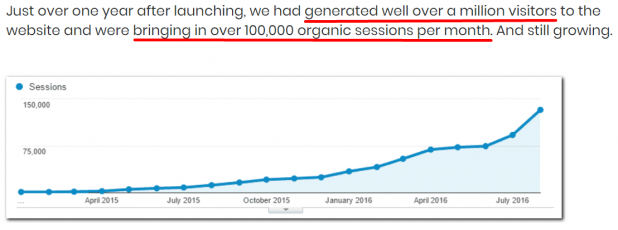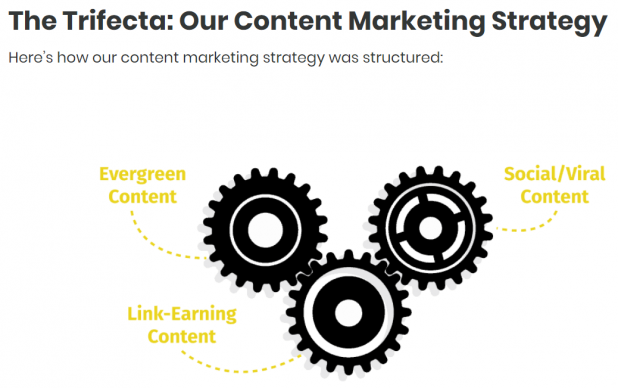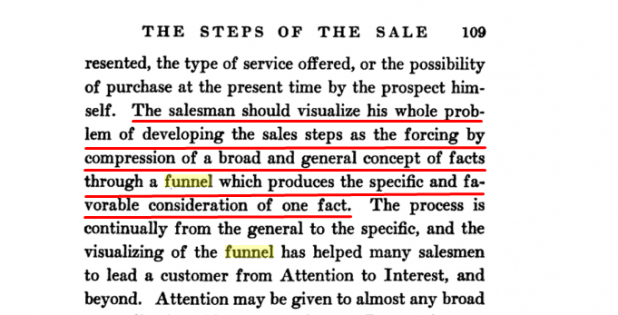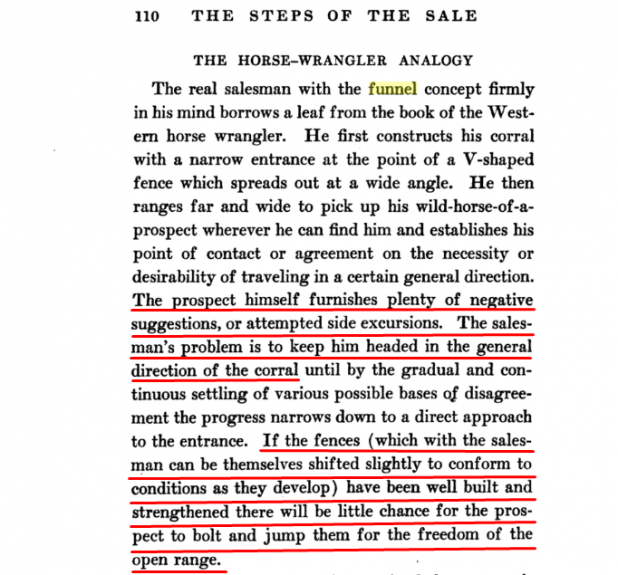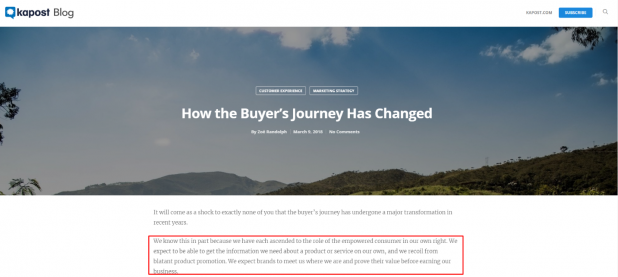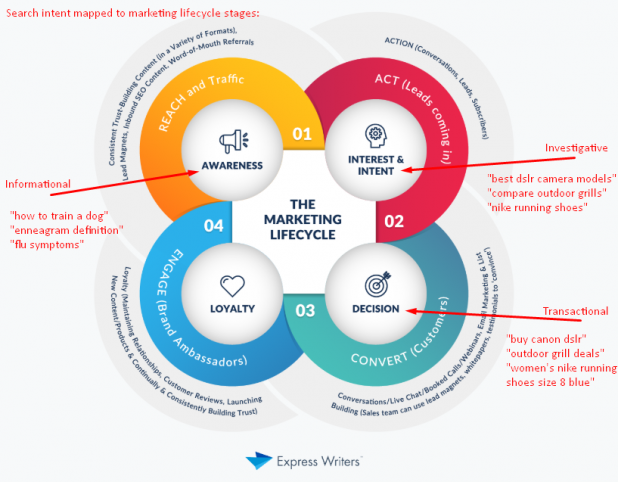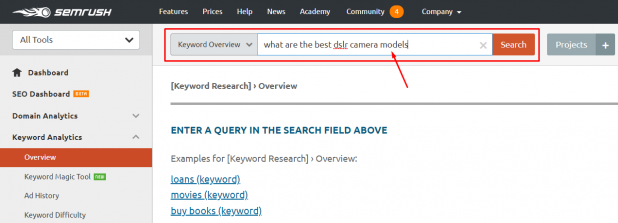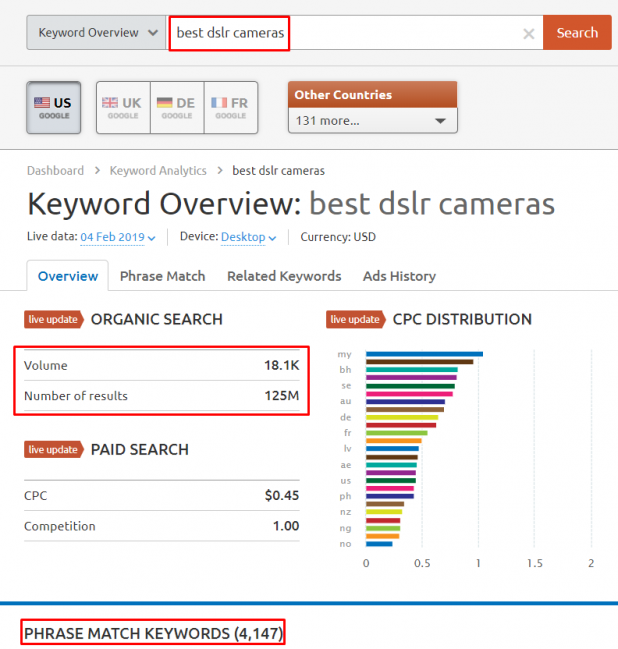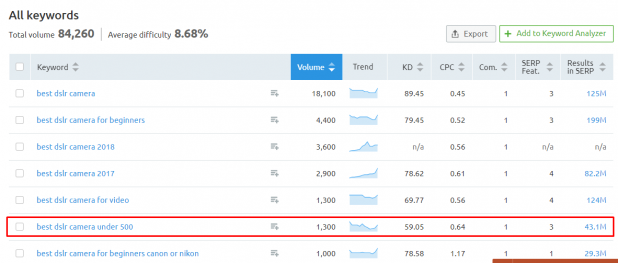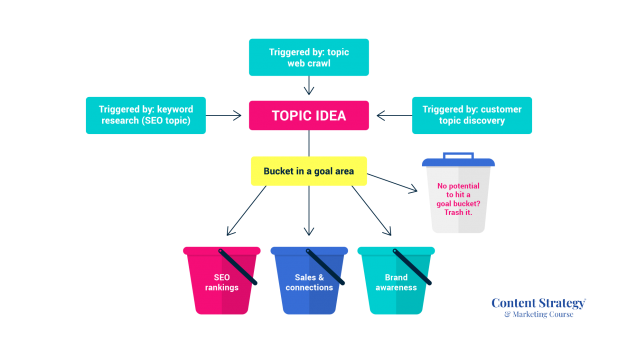What does strong content look like?
That’s the million-dollar question. If you can create strong content for your readers, you will get back as much as you put in.
Strong content brings in ROI you can’t argue with:
- More people reading your content from start to finish.
- More people actually learning from your content, gaining something valuable, or enjoying it.
- More clicks for your CTAs, and more people following through.
- More email subscribers.
- More leads coming in.
- More sales from those nurtured leads.
For a great example of a brand that leveraged strong content to meet nearly all of the above goals, let’s look at a case study from Optimist. They used amazing content as the pillar of a content marketing strategy for a brand called CollegeRaptor.
Here is what they achieved one year after launching their strategy:
- Over 1,000,000 visitors to the CollegeRaptor website
- Over 100,000 organic sessions per month
To do it, they honed in on their audience. They looked at what potential customers in a state of awareness were searching for and asking Google. Then, they created killer content in three major areas to answer those questions:
- Evergreen content
- Social/viral content
- Link-earning content
In other words, Optimist effectively mapped their content to their audience in the buyer’s journey/marketing lifecycle. They looked at what people who might need CollegeRaptor’s services were asking (“what’s a good ACT score?” or “what do colleges look for from students who apply?”). Then, they created great content around the answers.
Essentially, this is everything you need to create strong content that gets results.
Let’s break it down, step-by-step:
1. Start with Your Content Goals
In the above example, Optimist started with a basic understanding of the goals they wanted to achieve: Attract search traffic, generate backlinks, gain authority, and grow CollegeRaptor’s presence.
Similarly, when you begin, you need to understand what your goals are for your content. What do you want content marketing to do for your brand? Solidify those goals and make them your mantra. They should be at the heart of your resulting strategy.
2. Understand Your Audience in Terms of Search Intent and Lifecycle Marketing
This next part requires understanding two integral pieces of your content strategy: Your audience and their search intent.
Who is your audience persona? What answers are they looking for to solve their problem(s)? To find the answers, simply talking to them works, as well as creating surveys and researching on social media.
Once you know what questions your audience is asking, you can figure out how their search intent maps to the marketing lifecycle.
Why a Marketing Lifecycle Versus a Sales Funnel?
It’s important to think in terms of lifecycle marketing versus sales funnels because it’s in line with the nurturing stance of content marketing. We’re not looking to get the sale right this second; we instead want to warm up our audience, nurture their trust, and build relationships – that leads to repeat, loyal customers.
The marketing lifecycle is the modern antithesis to sales funnels. The latter was in use as far back as 1924 as a technique for one-on-one, in-person selling. We see one of the first mentions of a sales funnel in William Townsend’s book, Bond Salesmanship.
“Developing the sales steps” in terms of a sales funnel is described as “the forcing by compression of a broad and general concept of facts… which produces the specific and favorable consideration of one fact.”
In other words, the salesman pushes the prospect toward the conclusion that results in a sale. Interestingly, this sales process is compared to horse wrangling on the next page (!):
“If the fences … have been well built and strengthened there will be little chance for the prospect to bolt and jump them for the freedom of the open range.”
With sales funnels, the sale is all that matters. Your prospect isn’t a human, but rather a horse to be pushed, forced, and wrangled into a purchase – their free will is removed from the equation.
Yikes. This is what so many marketers are still relying on to guide their strategies?
We know that modern buyers don’t respond well to this kind of selling anymore. That’s because the internet has changed everything – the freedom of the open range IS the landscape. If you push, prod, and try to force your buyer using sales funnel tactics, they can and will jump that fence and find a brand that will treat them better, one that deserves their loyalty.
This article from Kapost sums that up particularly well:
“We expect to be able to get the information we need about a product or service on our own, and we recoil from blatant product promotion. We expect brands to meet us where we are and prove their value before earning our business.”
That’s another reason why a marketing lifecycle works better. We, as consumers, want brands to meet us where we stand. We don’t want to be forced into anything. That’s why, in a marketing lifecycle, there are no closed walls or fences. Each stage represents an open pathway, and the prospect is free to jump around depending on their experiences with your brand.
How to Map Search Intent to Lifecycle Stages
The very questions your audience is asking will show you where they stand in the marketing lifecycle. Once you map them to the right stage, you can create content that directly speaks to their needs. You will nurture a relationship rather than shove them toward a sale.
There are four basic types of search intent. Each maps to a different stage, like so:
- Navigational – Usually, the user just wants to navigate to a website but doesn’t know the exact URL (i.e. “CMI blog”, “Target”).
- Maps to: This type of search is the most basic and doesn’t map to a stage.
- Informational – The user is looking for information to solve a problem, close a knowledge gap, or improve their lives. (Examples: “how to train a dog”, “flu symptoms”)
- Maps to: Awareness
- Investigative – The user still wants information, but not just for the sake of knowledge. They may want help making a purchase decision, and they’re researching for that purpose. (Examples: “best dslr camera models”, “compare outdoor grills”)
- Maps to: Interest and Intent
- Transactional – The user wants to do something or carry out a specific action. Often, this means they’re ready to buy. (Examples: “buy canon dslr”, “outdoor grill deals”
- Maps to: Decision
Once you figure out what questions your audience is asking, you can create content that speaks to their marketing lifecycle stage and provides the answers they need.
For example, if your audience is asking “what are the best dslr camera models”, you could create a guide comparing and contrasting the top 10 to help them investigate.
For more information on mapping search intent to stages of buyer awareness, check out this great guide from GoDaddy: How to Create Search-Friendly Content for Each Stage of the Consumer Journey.
3. Generate Content Topics from Targeted Keywords
Once you have a question from your audience you want to answer (as well as the type of content to produce to hit your buyers’ stage of awareness), it’s time to find the best version of that phrase to target in your content.
In SEMrush, this is easy. First, type the phrase into the “Keyword Overview” search tool.
If there is zero data available about that exact keyword, tweak it until you get some results.
(I tweaked “what are the best dslr camera models” to “best dslr cameras”. If you’re targeting voice search, you may want to include the entire original question in your content piece along with relevant variations.)
Once you hit a keyword with data, check the competition. If it’s too high to rank for without a powerful domain authority (this one has a keyword difficulty score (KD) of 89.45/100 and a competition score of 1.00, or 100% – nope!), go to the Keyword Magic Tool.
We’re going to look at all of the keywords that broadly match this search to find an easier one to rank for.
We want to find the best keyword to use to target in our guide. Generally, this means hitting a sweet spot of low competition + good search volume.
Scanning the list of broad match keywords, I see a good opportunity with potential: “best dslr camera under 500”. It has 1,300 searches per month. The competition is still 1.00, but it has a much lower keyword difficulty score (KD) of 59.05.
Don’t forget to look at the “phrase match” keywords, too. You may find relevant keywords there that offer a good balance of KD/competition/search volume.
Once you find a good keyword, jot down a list of possible content topics using that phrase. Here are mine:
- The 10 Best DSLR Cameras Under $500
- How to Find the Best DSLR Camera Under $500
- The Best DSLR Camera Under $500: Our Review of the Canon EOS Rebel SL2
4. Map Content Topics to Your Goals
For my own content, I use something I call the 3-bucket topic strategy. Each content topic I come up with has to fit into one of my goal areas. If it doesn’t help me advance in that area, I scrap it.
This is the first major step to coming up with content that is great for you AND your readers. Even if you find a great keyword related to your ideal buyer’s search intent, if it doesn’t help you advance toward your goals, it’s not worth targeting in your content.
5. Create Utterly Readable, High-Quality Content
You found a relevant keyword you can use. You have a content topic in hand that will advance you toward one of your brand goals and maps to a stage of audience awareness.
At this point, creating strong content around your topic and keyword is KEY to bringing in ROI. Strong = readability + quality.
Create Readable Content
Strong content is readable content:
- It’s clear.
- It makes sense.
- The information is relevant to the user’s search.
- It flows together.
- The page the content is on doesn’t impede the user’s ability to read or understand it.
The more readable your content, the more likely a user will remain on your page. And, as we all know, that’s great for your search rankings. This is how Neil Patel puts it:
“Dwell time most definitely impacts SEO. If a user is spending time on a site, interacting with it, not bouncing, and going deeper within the content, it’s evident there is something of value on the site for that particular user. As this happens, SEO improves.”
Create High-Quality Content
Strong content is high-quality content:
- It is factually accurate.
- It is well-written and speaks to the target audience.
- It’s organized with headers, subheaders, and lists.
- It uses relevant sources to back up claims and provide evidence.
- It properly cites other websites and resources.
- It’s in-depth and long-form. It explores a topic fully.
- It includes examples to illustrate points, including images.
To rank in SERPs (and to rank well), you can’t have quality without readability, and vice-versa.
Ready to Rank with Google AND the Modern Reader?
Being strategic with your content is essential to both appealing to the modern reader and climbing Google’s rankings.
First, the way you consider your reader has to be in line with their buying journey. They don’t fit into sales funnels anymore – no modern buyer does – and that little thing called the internet has everything to do with the shift.
So, to appeal to today’s readers, meet them where they stand in the marketing lifecycle, which focuses on nurturing your prospects and building loyalty with them. Understand they have unlimited choices, and that sales funnels don’t properly reflect that fact with their closed walls, pushy mentality, and aggressive tactics.
In short, give the people what they want. You may just earn yourself some loyal customers who keep coming back for more.
Julia McCoy is a serial content marketer, entrepreneur, and bestselling author. She founded a multi-million dollar content agency, Express Writers, with nothing more than $75 at 19 years old. Today, her team has nearly 100 expert content creators on staff, and serves thousands of clients around the world. She’s earned her way to the top 30 worldwide content marketers, and has a passion for sharing what she knows in her books and in her online course, The Content Strategy & Marketing Course. Julia also hosts The Write Podcast on iTunes.
The post How to Create Content for Today’s Online Reader: Thinking in Terms of a Marketing Lifecycle appeared first on SiteProNews.

